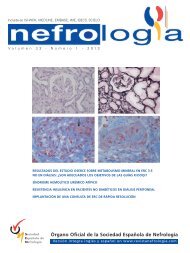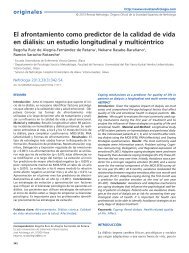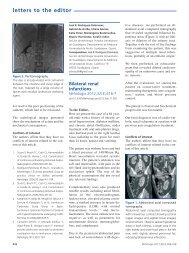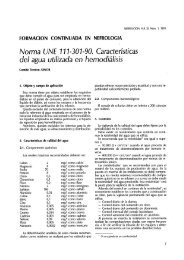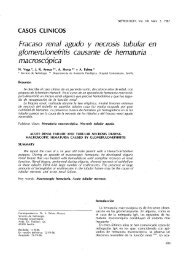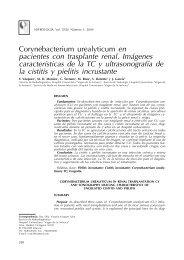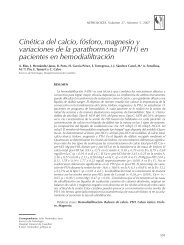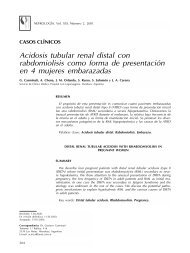PDF Número - NefrologÃa
PDF Número - NefrologÃa
PDF Número - NefrologÃa
Create successful ePaper yourself
Turn your PDF publications into a flip-book with our unique Google optimized e-Paper software.
I. Berdud et al. Anexo a la Guía de Centros de Diálisis<br />
guías S.E.N.<br />
ría deseable compartir protocolos de actuación comunes<br />
entre el hospital de referencia y sus centros de diálisis concertados.<br />
Estos protocolos deben incluir aspectos básicos<br />
del tratamiento del paciente renal (anemia, metabolismo<br />
mineral, accesos vasculares incluyendo infecciones de catéteres,<br />
etc., o plan de analíticas) como protocolo de trasplante,<br />
pruebas complementarias y otros particulares de la<br />
localidad. Esto no sólo unifica el abordaje de los pacientes,<br />
independientemente de dónde se le esté dializando, sino<br />
que también facilita el acceso a los datos de todos los pacientes<br />
de cara a ensayos clínicos y a trabajos de investigación.<br />
Acceso a la medicación. Los pacientes en diálisis precisan<br />
medicación de dispensación sólo hospitalaria, que es<br />
habitualmente suministrada, de acuerdo con el concierto,<br />
por el hospital de referencia. Sería recomendable que otra<br />
medicación no incluida en el concierto (antibióticos, urokinasa,<br />
suplementos nutricionales, etc.) fuera dispensada<br />
de la misma manera. Acceso al trasplante renal. La gestión<br />
de la lista de espera de trasplante, una vez el paciente inicie<br />
el tratamiento sustitutivo, debería hacerse como cualquier<br />
otro procedimiento, desde el centro de diálisis. Los<br />
nefrólogos de los centros, por tanto, deben conocer los<br />
protocolos y las novedades existentes en este sentido y<br />
participar de las reuniones que se hagan en cada hospital<br />
entre nefrología y urología. El protocolo de trasplante de<br />
cada localidad o cada Comunidad Autónoma debe seguirse<br />
en todos los pacientes, se realice la diálisis en el hospital<br />
o en un centro concertado. Características del trabajo<br />
en el centro. El médico que atienda a los pacientes en los<br />
centros de diálisis debe ser especialista en nefrología. Este<br />
tema, complicado, debe ser exigible en los conciertos de<br />
las Consejerías de Salud para garantizar la asistencia adecuada<br />
y equitativa de los enfermos que son sometidos a<br />
diálisis en centros concertados. Sólo en el caso de ausencia<br />
de nefrólogo se podría recurrir a un médico generalista<br />
con la adecuada formación en hemodiálisis. Esta formación<br />
debería, asimismo, estandarizarse. Más del 75% de los<br />
nefrólogos que trabajan en los centros están solos durante<br />
la jornada laboral y un 40% no coincide con ningún<br />
compañero durante toda la jornada. Habría que buscar,<br />
por parte de las empresas, fórmulas que favorecieran el<br />
contacto entre profesionales, tanto con el hospital como<br />
con nefrólogos de otros centros, y que permitiera el intercambio<br />
de ideas entre ellos. Formación. Los nefrólogos de<br />
los centros concertados tienen el deber y el derecho de investigar<br />
y de ampliar su formación de manera continuada<br />
para poder desarrollar y mejorar su labor asistencial.<br />
Dado que la mayoría de los pacientes en programa de hemodiálisis<br />
se encuentran en centros periféricos dependientes<br />
de hospitales de referencia, podría sugerirse una mínima<br />
rotación de los residentes de nefrología por algunos<br />
centros de diálisis concertados extrahospitalarios, previa<br />
acreditación para poder dar formación.<br />
Palabras clave: Hemodiálisis. Centro de diálisis. Hospital.<br />
Guías clínicas.<br />
Nefrologia 2011;31(6):664-9<br />
Appendix to Dialysis Centre Guidelines:<br />
Recommendations for the relationship between<br />
outpatient haemodialysis centres and reference hospitals.<br />
Opinions from the Outpatient Dialysis Group<br />
ABSTRACT<br />
Introduction: The different clinical guidelines backed<br />
by the Spanish Society of Nephrology (SEN) attempt to<br />
homogenise the monitoring of renal patients.<br />
However, this effort to homogenise treatment has<br />
been obstructed in the case of renal replacement<br />
therapy patients on haemodialysis due to, among<br />
other reasons, the existence of several different<br />
dialysis providers, with private centres located in many<br />
cities, each with their own reference hospitals and<br />
different criteria for treatment based on the existing<br />
outsourcing services agreements with the public health<br />
service, which also differ between regions. A good<br />
relationship between a private dialysis centre and its<br />
reference hospital would lead to equal treatment for<br />
all dialysis patients, at least at that particular town.<br />
The SEN, through the efforts of the Grupo de Trabajo<br />
de Hemodiálisis Extrahospitalaria (Outpatient<br />
Haemodialysis Group), has prioritised a close<br />
relationship and good communication between<br />
reference hospitals and dialysis centres in order to<br />
guarantee proper continuity of the health care given<br />
to these patients. Strategies for improvement:<br />
Conditions for referring patients from one centre to<br />
another. A patient that starts a haemodialysis<br />
programme should be referred from a reference<br />
hospital with a definitive vascular access for optimising<br />
treatment, with a full report updated within 24-48<br />
hours before the transferral, including essential<br />
information for providing proper nephrological<br />
treatment: primary pathology, recent viral serology<br />
(including hepatitis B and C virus [HBV and HCV] and<br />
human immunodeficiency virus [HIV]), parameters for<br />
anaemia and calcium-phosphorus metabolism, and<br />
ions, date of the first session of dialysis, and the<br />
number and dates of blood transfusions received.<br />
Furthermore, patients referred from the dialysis centre<br />
to the hospital, whether for programmed visits or<br />
emergency hospitalisation, should be accompanied by<br />
an updated report indicating the primary diagnoses,<br />
recent events, viral serology and laboratory analyses,<br />
updated haemodialysis and treatment regimens used,<br />
and the reason for transferral to the hospital. A single,<br />
digital clinical history that is accessible by both<br />
institutions would facilitate this situation, although<br />
this option is not completely available to all centres<br />
and hospitals. There are also legal issues to resolve in<br />
this aspect. Continued care for dialysis patients. Good<br />
communication between dialysis centres and hospitals<br />
is fundamental for achieving a proper level of care for<br />
dialysis patients, and not only with the nephrology<br />
department. The interconsultations of dialysis patients<br />
at each private centre, as well as the requests for<br />
diagnostic tests, should be able to be requested by the<br />
665



